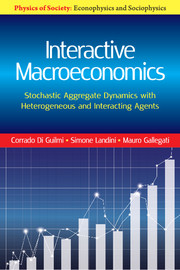3 - The Master Equation
from Part I - Methodological Notes and Tools
Published online by Cambridge University Press: 23 July 2017
Summary
This chapter introduces master equation (ME) modelling, which is widely used in hard sciences and encompasses pure probability, statistical physics and chemistry. The development of the ME involves a great deal of mathematical tools. However, this chapter introduces a very restricted set of basic notions and presents an even more restricted set of tools, in order to introduce the basic principles and provide a sufficient intuition. It highlights the potential of this approach to complex systems analysis and, in particular, for dealing with heterogeneity and interaction of agents.
Section 3.1 provides an introduction by recalling the notions introduced in Chapter 2. Section 3.2 introduces the ME from a very generic point of view: it shows how the ME can analytically describe processes in a discrete-space and continuous-time framework. Section 3.3 provides further developments in the case of Markov processes. In this section, the ME is introduced from the easiest case to the most general one, providing a short description of the stationary solution. Section 3.4 is devoted to the solution of the inferential problem of identifying the moments of the stochastic process described by the ME. The results presented in this section are of particular relevance with reference to the applications developed in the later chapters of Part II. This section provides the reader with the necessary background for understanding the analytical results developed in the application chapters, which involve more sophisticated techniques developed in Appendix B and C. The last Section 3.5 concludes.
Introduction
Chapter 2 introduced the notion of occupation numbers in equation (2.13) to evaluate how many units belong to a given class or subsystem of reference. Accordingly, the components of the occupation vector N(t), defined by equation (2.15), describe how agents of the system distribute over a set of states, classes or among subsystems. This distribution is given by the occupation numbers Nh(t) for each group indexed by h and defines the configuration of the system.
- Type
- Chapter
- Information
- Interactive MacroeconomicsStochastic Aggregate Dynamics with Heterogeneous and Interacting Agents, pp. 45 - 68Publisher: Cambridge University PressPrint publication year: 2016



